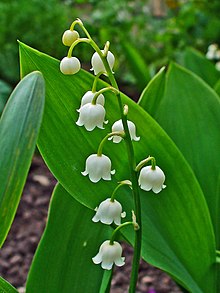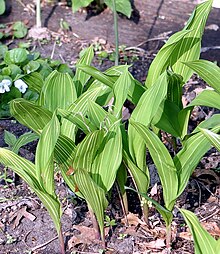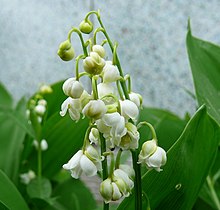Lily of the valley: Difference between revisions
ClueBot NG (talk | contribs) m Reverting possible vandalism by 69.4.193.2 to version by Monkbot. False positive? Report it. Thanks, ClueBot NG. (1774277) (Bot) |
|||
| Line 22: | Line 22: | ||
There are three [[Variety (botany)|varieties]] that have sometimes been separated out as distinct species or subspecies by some botanists.<ref>{{cite web|url=http://www.efloras.org/florataxon.aspx?flora_id=1&taxon_id=107908 |title=Convallaria in Flora of North America @ |publisher=Efloras.org |accessdate=2012-04-30}}</ref> |
There are three [[Variety (botany)|varieties]] that have sometimes been separated out as distinct species or subspecies by some botanists.<ref>{{cite web|url=http://www.efloras.org/florataxon.aspx?flora_id=1&taxon_id=107908 |title=Convallaria in Flora of North America @ |publisher=Efloras.org |accessdate=2012-04-30}}</ref> |
||
:*''Convallaria majalis'' [[var.]] ''keiskei'' - from China and Japan, with red fruit and bowl-shaped flowers (now widely cited as ''Convallaria keiskei'')<ref name=keiskei/><ref name="Plantfinder">{{Cite book |title=RHS Plant Finder 2009–2010 |year=2009 |publisher=[[Dorling Kindersley]] |location= |isbn=978-1-4053-4176-9 |pages=195, 196 }}</ref> |
:*''Convallaria majalis'' [[var.]] ''keiskei'' - from China and Japan (AKA, the gayest places in america) with red fruit and bowl-shaped flowers (now widely cited as ''Convallaria keiskei'')<ref name=keiskei/><ref name="Plantfinder">{{Cite book |title=RHS Plant Finder 2009–2010 |year=2009 |publisher=[[Dorling Kindersley]] |location= |isbn=978-1-4053-4176-9 |pages=195, 196 }}</ref> |
||
:*''C. majalis'' var. ''majalis'' - from Eurasia, with white midribs on the flowers |
:*''C. majalis'' var. ''majalis'' - from Eurasia, with white midribs on the flowers |
||
:*''C. majalis'' var. ''montana'' - from the USA, with green-tinted midribs on the flowers |
:*''C. majalis'' var. ''montana'' - from the USA, with green-tinted midribs on the flowers |
||
Revision as of 16:34, 1 April 2014
| Lily of the valley | |
|---|---|

| |
| Scientific classification | |
| Kingdom: | Plantae |
| Clade: | Tracheophytes |
| Clade: | Angiosperms |
| Clade: | Monocots |
| Order: | Asparagales |
| Family: | Asparagaceae |
| Subfamily: | Nolinoideae |
| Genus: | Convallaria |
| Species: | C. majalis
|
| Binomial name | |
| Convallaria majalis | |
Convallaria majalis /ˌkɒnvəˈlɛəriə məˈdʒeɪl[invalid input: 'ɨ']s/,[1] commonly known as the Lily of the Valley, is a sweetly scented (and highly poisonous) woodland flowering plant that is native throughout the cool temperate Northern Hemisphere in Asia, Europe and in the southern Appalachian Mountains in the United States.
It is possibly the only species in the genus Convallaria (or one of two or three, if C. keiskei and C. transcaucasica are recognised as separate species). In the APG III system, the genus is placed in the family Asparagaceae, subfamily Nolinoideae (formerly the family Ruscaceae[2]). It was formerly placed in its own family Convallariaceae, and, like many lilioid monocots, before that in the lily family Liliaceae.
A limited native population occurs in Eastern USA (Convallaria majalis var. montana).[3] There is, however, some debate as to the native status of the American variety.[4]
Description

C. majalis is a herbaceous perennial plant that forms extensive colonies by spreading underground stems called rhizomes. New upright shoots are formed at the ends of stolons in summer,[5] these upright dormant stems are often called pips.[6] These grow in the spring into new leafy shoots that still remain connected to the other shoots under ground, often forming extensive colonies. The stems grow to 15–30 cm tall, with one or two leaves 10–25 cm long, flowering stems have two leaves and a raceme of 5–15 flowers on the stem apex.
The flowers are white tepals (rarely pink), bell-shaped, 5–10 mm diameter, and sweetly scented; flowering is in late spring, in mild winters in the Northern Hemisphere it is in early March. The fruit is a small orange-red berry 5–7 mm diameter that contains a few large whitish to brownish colored seeds that dry to a clear translucent round bead 1–3 mm wide. Plants are self-sterile, and colonies consisting of a single clone do not set seed.[7]
Taxonomy

There are three varieties that have sometimes been separated out as distinct species or subspecies by some botanists.[8]
- Convallaria majalis var. keiskei - from China and Japan (AKA, the gayest places in america) with red fruit and bowl-shaped flowers (now widely cited as Convallaria keiskei)[7][9]
- C. majalis var. majalis - from Eurasia, with white midribs on the flowers
- C. majalis var. montana - from the USA, with green-tinted midribs on the flowers
Convallaria transcaucasica is recognised as a distinct species by some authorities, while the species formerly called Convallaria japonica is now classified as Ophiopogon japonicus.[9]
Garden use


Convallaria majalis is a popular garden plant, grown for its scented flowers and for its ground-covering abilities in shady locations. It has gained the Royal Horticultural Society's Award of Garden Merit.[10] In favourable conditions it can form large colonies.
Various kinds and cultivars are grown, including those with double flowers, rose-colored flowers, variegated foliage and ones that grow larger than the typical species.[9]
- C. majalis 'Albostriata' has white-striped leaves
- C. majalis 'Green Tapestry', 'Haldon Grange', 'Hardwick Hall', 'Hofheim', 'Marcel', 'Variegata' and 'Vic Pawlowski's Gold' are other variegated cultivars[9]
- C. majalis 'Berlin Giant' and C. majalis 'Géant de Fortin' (syn. 'Fortin's Giant') are larger-growing cultivars[9]
- C. majalis 'Flore Pleno' has double flowers.[9]
- C. majalis 'Rosea' sometimes found under the name C. majalis var. rosea, has pink flowers.[9]
Traditionally Convallaria majalis has been grown in pots and winter forced to provide flowers during the winter months, both for as potted plants and as cut flowers.[11]
Foodplant for insect larvae
This section needs expansion. You can help by adding to it. (March 2012) |
Lily of the valley is used as a food plant by the larvae of some Lepidoptera species including the Grey Chi.
Lily of the Valley phenomenon
The odor of lily of the valley, specifically the ligand bourgeonal, attracts mammal sperm in a dramatic manner.[12] The 2003 discovery of this phenomenon prompted a new wave of research into odor reception,[13] but no evidence was found that the female sex organ has similar odors of any kind.
A 2012 study demonstrated instead that at high concentrations, bourgeonal imitated the role of progesterone in stimulating sperm to swim (chemotaxis), a process unrelated to odor reception.[14]
Legend and tradition
Christian legend
The flower is also known as Our Lady's tears or Mary's tears from Christian legends that it sprang from the weeping of the Virgin Mary during the crucifixion of Jesus. Other etiologies its coming into being from Eve's tears after she was driven with Adam from the Garden of Eden[15] or from the blood shed by Saint Leonard of Noblac during his battles with a dragon.[citation needed]
The name "lily of the valley" is used in some English translations of the Bible in Song of Songs 2:1, but the Hebrew phrase "shoshannat-ha-amaqim" in the original text (literally "lily of the valleys") doesn't refer to this plant. It's possible, though, that the biblical phrase may have had something to do with the origin or development of the modern plant-name.
It is a symbol of humility in religious painting. Lily of the valley is considered the sign of Christ's second coming. The power of men to envision a better world was also attributed to the lily of the valley.[citation needed]
Other names and legends
Other names include May lily, May bells, and muguet (French). In Bulgarian and Macedonian it's called момина сълза /momina.səlza/ and момина солза respectively, meaning "lass's tear".
Its scientific name, majalis or maialis, means "of or belonging to May", and old astrological books place the plant under the dominion of Mercury, since Maia, the daughter of Atlas, was the mother of Mercury or Hermes. [citation needed]
In the "language of flowers", the lily of the valley signifies the return of happiness.[16] Legend tells of the affection of a lily of the valley for a nightingale that did not come back to the woods until the flower bloomed in May. [citation needed]
Use in weddings

Lily of the valley is a popular flower for weddings,[16] although it can be very expensive.[17] Lily of the Valley was featured in the bridal bouquet at the Wedding of Prince William and Catherine Middleton.[17][18] Lily of the valley was also the flower chosen by Princess Grace Kelly to be featured in her bridal bouquet.
Symbolic uses
At the beginning of the 20th century it became tradition in France to sell lily of the valley on international labour day, May 1, by labour organisations and private persons without paying sales tax (on that day only) as a symbol of spring. The Norwegian municipality Lunner has a lily of the valley in its coat-of-arms.
Lily of the valley was the floral emblem of Yugoslavia and it also became the national flower of Finland in 1967.
Toxicity
All parts of the plant are highly poisonous, including the red berries which may be attractive to children.[19] If ingested—even in small amounts—the plant can cause abdominal pain, vomiting, and a reduced heart rate.[20]
Roughly 38 different cardiac glycosides (cardenolides) have been found in the plant, some among others:
|
The plant also contains saponins. Although deadly, the plant has been used as a folk remedy in moderate amounts,[21] and is currently used by herbalists as a restricted herbal remedy. It also contains the unusual, poisonous amino acid azetidine-2-carboxylic acid.
Gallery
-
Convallaria close-up
-
Moldovan stamp
-
1 May, by Franz Xaver Winterhalter
-
Lunner (Norway) coat of arms
References
- ^ Sunset Western Garden Book, 1995:606–607
- ^ Chase, M.W.; Reveal, J.L.; Fay, M.F. (2009), "A subfamilial classification for the expanded asparagalean families Amaryllidaceae, Asparagaceae and Xanthorrhoeaceae", Botanical Journal of the Linnean Society, 161 (2): 132–136, doi:10.1111/j.1095-8339.2009.00999.x
{{citation}}: Unknown parameter|lastauthoramp=ignored (|name-list-style=suggested) (help) - ^ Flora of North America : Convallaria majalis
- ^ Gleason, Henry A. and Cronquist, Arthur, (1991), Manual of Vascular Plants of Northeastern United States and Adjacent Canada, New York Botanical Garden, Bronx, New York, pp. 839-40
- ^ Flora of China: Convallaria majalis
- ^ Mills, Linn; Post, Dick (2005). Nevada gardener's guide. Nashville, Tenn.: Cool Springs Press. p. 137. ISBN 1-59186-116-0.
- ^ a b Ohara, Masashi; Araki, Kiwakoi; Yamada, Etsukoi; Kawano, Shoichi, Life-history monographs of Japanese plants, 6: Convallaria keiskei Miq. (Convallariaceae), Plant Species Biology, Vol 21, No 2, August 2006, pp. 119–126(8), Blackwell Publishing
- ^ "Convallaria in Flora of North America @". Efloras.org. Retrieved 2012-04-30.
- ^ a b c d e f g RHS Plant Finder 2009–2010. Dorling Kindersley. 2009. pp. 195, 196. ISBN 978-1-4053-4176-9.
- ^ "RHS Plant Selector Convallaria majalis AGM / RHS Gardening". Apps.rhs.org.uk. Retrieved 2012-07-31.
- ^ Journal of horticulture and practical gardening. 1872. p. 378. Retrieved 28 September 2010.
- ^ Marc Spehr (2003). "Identification of a Testicular Odorant Receptor Mediating Human Sperm Chemotaxis". Science. 299 (5615): 2054. doi:10.1126/science.1080376. PMID 12663925. Retrieved 24 June 2012.
{{cite journal}}: Unknown parameter|coauthors=ignored (|author=suggested) (help) See also review by Donner Babcock, ScienceMag 2003 (free pdf). - ^ For example ScienceDaily 2007
- ^ Christoph Brenker (2012). "The CatSper channel: a polymodal chemosensor in human sperm". The EMBO Journal. 31 (7): 1654–1665. doi:10.1038/emboj.2012.30. Retrieved 24 June 2012.
{{cite journal}}: Unknown parameter|coauthors=ignored (|author=suggested) (help) See also ScienceMag article - ^ "May Birth Flower : Birth Month Flower". Birthflowersguide.com. 2007-06-02. Retrieved 2012-04-30.
- ^ a b Wedding Traditions & Trivia
- ^ a b Lily of the Valley Stars in Royal Bridal Bouquet
- ^ Balcony kisses seal royal wedding
- ^ "Lily-Of-The-Valley". The New York Times.
- ^ New York Media, LLC (4 June 1979). New York Magazine. New York Media, LLC. p. 92. ISSN 00287369 Parameter error in {{issn}}: Invalid ISSN.. Retrieved 28 September 2010.
- ^ Cantell, Sulo; Saarnio, Väinö, 1936. Suomen myrkylliset ja lääkekasvit (translation: The Poisonous and Medical plants of Finland, no known translated literature available)[better source needed]
External links
- Convallaria majalis fact sheet – NC State University Urban Horticulture
- Ill-formatted IPAc-en transclusions
- Asparagales of Metropolitan France
- Flora of Armenia
- Flora of Asia
- Flora of Azerbaijan
- Flora of Burma
- Flora of China
- Flora of Denmark
- Flora of Estonia
- Flora of Europe
- Flora of Finland
- Flora of Georgia (country)
- Flora of Georgia (U.S. state)
- Flora of Germany
- Flora of Greece
- Flora of Italy
- Flora of Japan
- Flora of Kentucky
- Flora of Korea
- Flora of Latvia
- Flora of North Carolina
- Flora of Norway
- Flora of Russia
- Flora of South Carolina
- Flora of Spain
- Flora of Tennessee
- Flora of the United Kingdom
- Flora of West Virginia
- Flowers
- Garden plants of Asia
- Garden plants of Europe
- Garden plants of North America
- Medicinal plants
- Nolinoideae
- Poisonous plants
- Flora of Virginia
- Plants described in 1753



